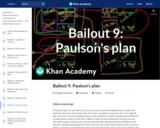
What Paulson wants to do and why I don't like it. Created by Sal Khan.
- Subject:
- Economics
- Social and Behavioral Sciences
- Material Type:
- Lesson
- Provider:
- Khan Academy
- Provider Set:
- Khan Academy
- Author:
- Sal Khan
- Date Added:
- 08/10/2021

What Paulson wants to do and why I don't like it. Created by Sal Khan.
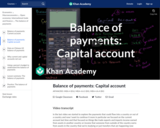
In this video, we explore how changes in foreign ownership of assets affects balance of payments. Created by Sal Khan.
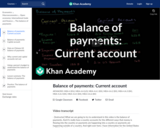
Learn about the balance of payments (BOP) in this video that explores the current account for the United States in 2011. Topics include what is included in the current account balance and what a current account deficit is. Created by Sal Khan.

This video breaks down a bank's balance sheet even further by walking through assets, liabilities, equity, required reserves, and excess reserves.
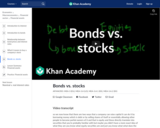
Learn about the difference between stocks and bonds. Topics include the key characteristics that define an asset as a bond vs. a stock. Created by Sal Khan.
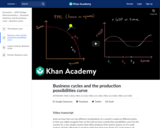
This video demonstrates how different points of the business cycle correspond to the production possibilities curve. The discussion includes unemployment, inflation, expansions, recessions and economic growth.

Video of Sal on CNN on October 10th discussing the credit crisis and a potential solution to it. Created by Sal Khan.

Recall that the tax multiplier and expenditure multiplier magnify the effect of any change in spending or taxes. In this video, we use that fact to calculate the amount of spending or tax change necessary to close output gaps.

In this video we take a slightly different approach to understanding the difference between real and nominal values: find the value of an asset in a previous year's dollars. Created by Sal Khan.
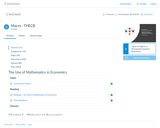
Textbook
The book for this course is Macroeconomics and uses a book from OpenStax which was created by Rice University.
Videos
Images for videos come from the following sources with voice over from Professor Richard Gosselin at Houston Community College who is solely responsible for their content. There are 179 videos for the macroeconomics course with an average run time of about five minutes each. They were produced using three sources - desktop screen capturing via Screenflow which is a product of Telestream, as well as One Button Studio and the Learning Glass for live in-person mini-lectures filmed in a studio. Nearly all the video have been closed-captioned for the hearing impaired using professionals rather than automation. There are also downloadable transcripts embedded for each video and a download feature for users. Houston Community College footed the expense of the closed-captioning service. I would like to thank the college administration as well as Ruben Duran, Senior Media Developer at the college for assisting with this.
OpenStax Macroeconomics, Second Edition
Principles of Economics is adapted from a work produced and distributed under a Creative Commons license
(CC BY-NC-SA) in 2011 by a publisher who has requested that they and the original author not receive attribution. This adapted edition is produced by the University of Minnesota Libraries Publishing through the eLearning Support Initiative. This adaptation has reformatted the original text and replaced some images and figures to make the resulting whole more shareable. This adaptation has not significantly altered or updated the original 2011 text. This work is made available under the terms of a Creative Commons Attribution-NonCommercial-ShareAlike license.
Test Bank
The original test bank provided by Open Stax provided 1158 questions, 955 were multiple choice and 203 were short answer questions. Under this grant there were no additional short answer questions added however, there are now 1418 questions in the new test bank which is the result of adding 260 questions of the following variety - multiple choice, fill in the blank, numerical questions, multiple drop-down questions, multiple-response questions, matching and formula questions which present each student with different values and parameters. Images in the test bank, unless otherwise noted are licensed under the Creative Commons and most are the product of unknown authors.
Review PowerPoint Slides
These were provided by Intellus Learning Open Courses
This work is licensed under a Creative Commons Attribution 4.0 International (Links to an external site.) License. The material for these slides and the image come directly from Macroeconomics OpenStax, Second edition.
Discussion Questions
These were authored by Richard Gosselin at Houston Community College and are licensed under the Creative Commons. There are over 70 discussion questions available.
Flash Card Powered by Quizlet
These were authored by Richard Gosselin with a couple of exceptions. They are based on the terms in Macroeconomics, Second edition. They are also licensed under the Creative Commons and are freely distributable. There are 21 such quizzes, one for each chapter.
Excel Exercises and Videos
26 Excel assignments were created including practice assignments and videos to assist students with basic features of Excel which help them create a file, save data, sort data, create tables, line graphs, bar graphs and pie chart and much more.
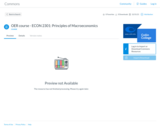
This is a Principles of Macroeconomics course utilizing exclusively Open Educational Resources and designed in Canvas. This course is mapped to the Learning Outcomes for ECON 2301 as established under the Texas Higher Education Coordinating Board Academic Course Guide Manual. This course is based on Openstax Principles of Macroeconomics 2e textbook and incorporates key components from EDUC 1301: Learning Frameworks, designed to enhance the student’s experience as well as to improve overall student learning.
The course was developed by a faculty team from Collin College as part of the Texas Higher Education Coordinating Board OER Course Development and Implementation Grant Program.

An introduction to the book Capital by Thomas Piketty. Created by Sal Khan.
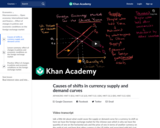
Exchange rates are determined in the foreign exchange market, but what causes those exchange rates to change? In this video, learn about why the supply or demand for a currency might change.
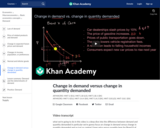
In this video we illustrate and explain the differences between a change in the quantity demanded for a good (which causes a movement along a demand curve) and the change in a good's demand (which causes the entire demand curve to shift).

A demand shifter is a change that shifts the demand curve for a product. One of the demand shifters is buyers' expectations. If a buyer expects the price of a good to go down in the future, they hold off buying it today, so the demand for that good today decreases. On the other hand, if a buyer expects the price to go up in the future, the demand for the good today increases. Explore the role of buyers' expectations as a determinant of demand in this video. Created by Sal Khan.
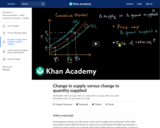
A common error new economic students make is confusing changes in supply with changes in quantity supplied. A change in quantity supplied is a movement along the supply curve in response to a change in price. A change in supply is a shift of the entire supply curve in response to something besides price.
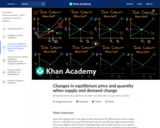
Previously we looked at what happens to the equilibrium price and quantity in a market if supply or demand change. In this video, we explore what happens when BOTH supply and demand are changing at the same time.
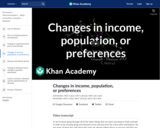
In this video, we explore how changes in a few factors affect the demand curve. Changes in income, population, and consumer preferences cause the entire demand curve to shift. Created by Sal Khan.
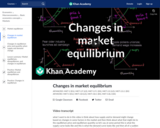
When supply or demand change, the price and quantity in the market changes. See how a change in demand or supply affects price and quantity in this video. Created by Sal Khan.
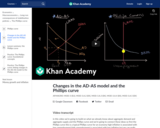
Economists who studied the relationship between inflation and unemployment made an important modification to the Phillips curve model with the addition of the long-run Phillips curve (LRPC). When expectations are factored in, and there is enough time to adjust, the Phillips curve is vertical. Explore why in this video.